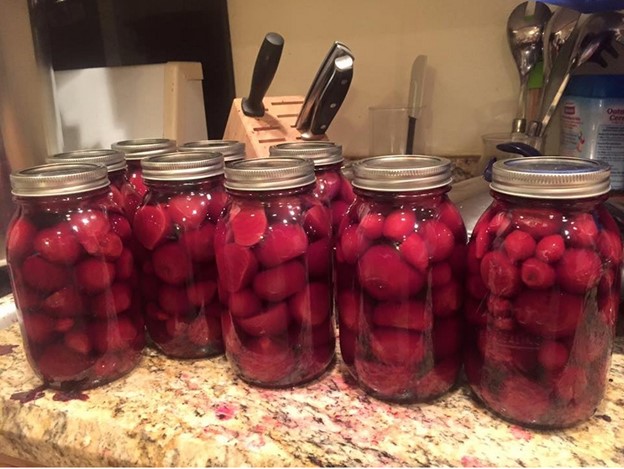Preserving summer’s tomato bounty is a time-honored tradition that fills pantries with bright, flavorful jars of tomatoes ready to be used in sauces, soups, and stews all year long.
Canning whole tomatoes at home and preserving them is a rewarding process that requires attention to detail, proper equipment, and a few simple ingredients.
This guide will walk you through everything you need to safely and successfully can whole tomatoes using the water bath method.
Why Can Whole Tomatoes?
Table of Contents
Whole canned tomatoes are versatile—they can be crushed, pureed, or cooked down into sauce as needed. Home-canned tomatoes also have a fresher taste and fewer additives than store-bought versions. Plus, preserving your own tomatoes helps reduce waste and can save money over time.
What You’ll Need To Can Whole Tomatoes

Before you begin, gather all the necessary ingredients and tools to streamline your canning process.
Ingredients:
- Fresh, ripe tomatoes (preferably Roma or plum varieties for their lower water content)
- Bottled lemon juice or citric acid
- Salt (optional, for flavor)
- Equipment:
- Large pot for blanching tomatoes
- Slotted spoon
- Large bowl with ice water
- Canning jars (pint or quart), lids, and rings
- Jar lifter or tongs
- Canning funnel
- Bubble remover or plastic spatula
- Large stockpot or water bath canner with a rack
- Clean kitchen towels
Step-by-Step Instructions To Can Whole Tomatoes
Follow this step-by-step guide to can whole tomatoes:
Prepare the Tomatoes

- Start by cleaning and peeling the tomatoes to get them ready for canning.
- Wash the tomatoes thoroughly.
- Score the bottoms of each tomato with a shallow “X” to make peeling easier.
- Blanch tomatoes by boiling them for 30–60 seconds until the skins loosen.
- Transfer to an ice bath to cool quickly and stop cooking.
- Peel the skins off by hand once cooled. Leave tomatoes whole or halve if preferred.
Sterilize the Jars
- Ensuring your jars are clean and hot is key to preventing contamination.
- Wash jars, lids, and bands in hot, soapy water.
- Keep jars hot until ready to use—either in simmering water or a warm oven (about 200°F/93°C).
- Do not boil the new-style lids; just keep them clean and warm.
Add Acid
As tomatoes are not acidic enough on their own, you’ll need to add acid to each jar to ensure safe preservation.
- Add to each jar:
- 1 tablespoon bottled lemon juice (per pint) or 2 tablespoons (per quart)
- OR ¼ teaspoon citric acid (pint) / ½ teaspoon (quart)
- This step is essential for food safety, even if you’re using low-acid or heirloom tomato varieties.
Fill the Jars

Now it’s time to pack the prepared tomatoes into jars and get them ready for canning.
- Use a canning funnel to add tomatoes into jars. Press gently to release air pockets but do not crush.
- Optional: Add ½ teaspoon salt per pint (1 teaspoon per quart) for flavor.
- Leave ½ inch headspace at the top of each jar.
- Remove bubbles by running a plastic spatula or bubble remover along the inside edges.
- Wipe the rims with a damp towel to ensure a good seal.
- Apply the lids and screw on the bands until fingertip tight.
Process the Jars
Next, you’ll use the water bath canning method to safely preserve your tomatoes.
- Place jars into a boiling water bath canner with enough water to cover jars by at least 1–2 inches.
- Bring to a full rolling boil.
- Process time:
- Pints: 40 minutes
- Quarts: 45 minutes
- Adjust for altitude if necessary—consult your local extension service.
- Turn off the heat and let jars sit in water for 5 minutes before removing.
Cool and Store
- Proper cooling and storage ensure your canned tomatoes stay safe and tasty for the long haul.
- Remove jars using a jar lifter and place them on a towel or cooling rack, spaced apart.
- Let jars cool for 12–24 hours.
- Check seals: lids should not flex when pressed in the center.
- Label jars with the date and store in a cool, dark place for up to 12–18 months.
Additional Tips To Can Whole Tomatoes
Here are some helpful pointers to make sure your tomato canning project is a success.
Use ripe but firm tomatoes. Overripe tomatoes can become mushy when canned.
Always add acid, even if tomatoes taste acidic.
Never reuse canning lids. Use new lids for every batch to ensure a safe seal.
If a jar doesn’t seal, refrigerate and use within a week or reprocess within 24 hours.
Wrapping Up
Canning whole tomatoes is a simple yet satisfying project that pays off year-round. With a few hours of work and careful attention to safe canning practices, you’ll have jars of vibrant, delicious tomatoes ready for countless homemade meals. Happy canning!
Leave a Reply